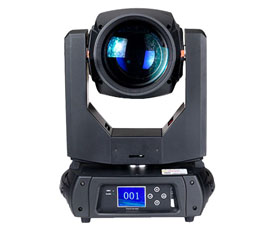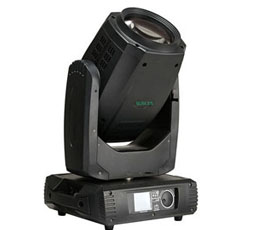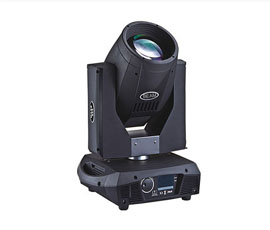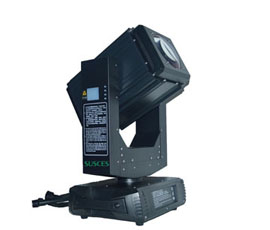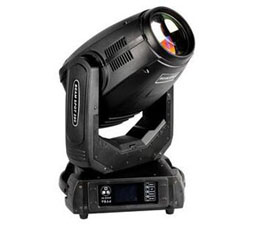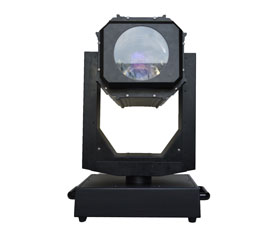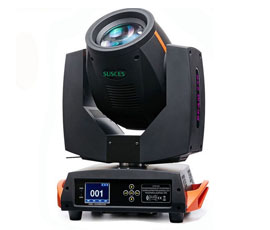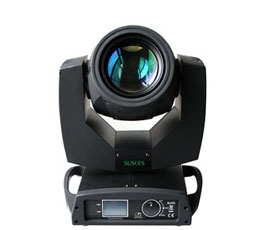
Record 3D sounds for music classes
3D is a popular term in recent years to 3D movies, 3D TV, 3D games, 3D projection, as the representative of the 3D imaging technology has become a hot topic in the field of video. And audio, 3D sound (also known as immersion sound) is becoming a new direction of development. Over the past two years, the audio field of important international conferences, such as AES (Audio EngineerSociety) meeting, the German sound engineer meeting (Tonmeistertaguang), will be 3D voice as an important topic of discussion; national research institutions and equipment manufacturers are also focused on research and development New technology for 3D sound, new equipment. The author starts with the basic concepts and characteristics of 3D sound, introduces a series of common 3D sound technology solutions, and summarizes the 3D sound recording methods for music programs.
Characteristics and Development of 13D Sound Technology
3D (3-dimensional), usually translated into three-dimensional, usually refers to the spatial dimension, that is, with long, wide, high three vector three-dimensional space. 3D sound can be understood as a certain technical means to record and reproduce the sound of three-dimensional information.
The human ear has the ability to perceive the three-dimensional sound field and locate the three-dimensional spatial image. Sound recording and playback technology from monaural, two-channel flat stereo to 5.1,7.1 plane surround sound, its sound field shaping ability from one-dimensional space to the development of horizontal two-dimensional space. The 3D sound technology and 3D graphics technology is mainly different in depth, mainly to expand the audio system in the vertical direction of the sound field shaping ability, you can simulate the real listening experience with the most close to the three-dimensional sound space.
1.1 3D sound technology features
3D sound technology and the use of equipment, not only to bring people a new sound aesthetic experience, and because of the sound space expansion, sound creation space and freedom to obtain an unprecedented improvement. Its characteristics and advantages can be summarized as the following points.
(1) 3D sound technology presence and deep sense of immersion. In peoples listening habits, sounds from above and obliquely above are carrying more information that helps identify the sound field. 3D sound playback technology allows the audience to be in a three-dimensional voice playback space, the sound field to reproduce and listen to the natural environment close to the experience, this telepresence is flat and surround sound can not match.
(2) 3D sound technology to expand the vertical direction of the sound image positioning to make the sound field information more complete. The appearance of the vertical direction of the sound image positioning so that the sound movement trajectory is more free, coherent, and further enriched the artistic expression of the sound.
(3) 3D sound technology improves the sound quality of playback sound. From the mono to the plane of the development process can be seen, the less the number of channels, a single channel contains more information on the sound, it is prone to the signal between the sound and phase offset of the phenomenon. At present, most of the common 3D sound system has increased the top or oblique above the speaker, so to a certain extent, ease the sound dyeing and phase offset problem. The double-blind sound quality comparison test results of the Fraunhofer Institute in Germany (see Figure 1) also show that the overall sound quality of the sound is greatly improved when the extra channel speakers are added.
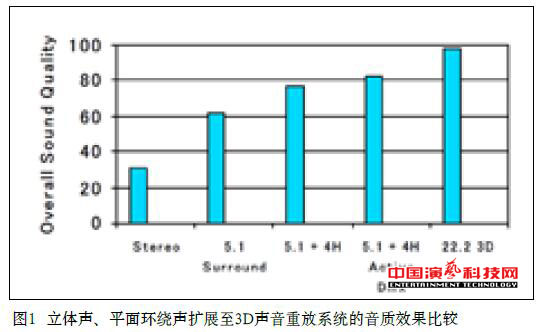
环境的(4) 3D sound technology to expand the best listening area. One of the advantages of flat surround sound relative to two-channel flat stereo is the best listening area to expand, and the 3D sound reproduction system is further expanded on the basis of the plane surround sound. This is the author who have personal experience, set up in the German audio division meeting 3D audio-visual room, the author specifically in a number of locations were compared to listen to feel the sound reduction and consistency of the sound field is very good, although in different locations There will be some differences, but did not appear too extreme changes in the effect.
1.2 3D sound technology development status quo
In recent years, 3D sound technology has entered the fast lane of development. A large number of products from the research institutions and equipment manufacturers to the laboratory of the laboratory, some of which have been in the ordinary audience and industry experts get a better evaluation and wide acceptance. Currently common 3D sound technology solutions are: Dolby Atmos (Dolby panorama), Auro 3D, IOSONO-3D, NHK22.2, DTS-X, HOA (High Order Ambisonics high-order sound field copy) and so on. In the case of sound signal distribution, the common 3D sound system can be divided into two types based on "channel" and "object".
1.2.1 3D sound technology based on "channel"
Based on the "channel" of the 3D sound technology using a traditional flat stereo and surround sound similar to the signal distribution method, through different speakers to reproduce the sound information between the intensity difference and time difference positioning sound source. The use of this principle of 3D sound technology solutions include Auro 3D, NHK22.2 and so on.
1.2.2 3D sound technology based on "object"
Based on the "object" of the 3D sound technology to break the traditional channel-based voice signal distribution, voice production in the link to add a dedicated encoding processor, the sound of the spatial location information recorded as a series of metadata, these The metadata does not belong to any one of the physical channels, and the decoder uses the decoder to reproduce the corresponding speaker of the playback system using the voice positioning information of the metadata. Belong to this type of 3D sound technology solutions include Dolby Atmos, DTS-X, IOSONO-3D and so on. The IOSONO-3D system decodes and replaces the metadata and uses the Wave Field Synthesis based on the Huygens principle (the principle of the secondary wave source).
2 3D music recording of music programs At present, 3D sound technology is mainly for film, game technology research and program production, for the music program produced 3D sound research less, but in view of the current music performance market and television music variety show Of the hot, music programs may be the next 3D sound technology application research hotspot. 2.1 Auro 3D technology in the field of music recording Through the existing music program 3D sound recording methods of analysis and comparison, we can find most of the current music program 3D sound simultaneous recording production program is based on Auro 3D technology program Design, and replay in the Auro 3D system. Auro 3D technology program in the music program 3D playback field occupies an important position. The following is from the sound characteristics of music programs and Auro 3D technology program features such as the analysis of its music in the field of recording is widely used reasons. (1) from the sound of the artistic performance point of view, the film sound and music sound have their own different artistic pursuit. The film sound needs to cooperate with the film screen, not only need to reproduce the screen presented by the sound field environment, but also requires accurate sound image positioning and restore the sound object trajectory. And music class programs, especially classical music programs are not too many sports sound source positioning requirements, even if the need for sound and image positioning, a lot of time is not a point but need a certain width. The focus of recording this program is to shape the sound field, simulate a more natural music performance environment, bring the audience more realistic immersive experience. So, although similar to Dolby Atmos based on the "object" of the signal distribution can reproduce a more accurate three-dimensional sound image positioning, but the music program to leave it very limited space. (2) traditional music recording Whether it is the same period of stereo, surround sound system recording or phased single point pickup and post-production, the theoretical basis is the traditional "channel" of the playback system. In the Auro 3D system based on the "channel" replay, the musician can take advantage of all the traditional recordings that have been mastered by itself, and the work habits and working methods are almost no change before, but only need to consider adding the upper microphone Group to provide the corresponding audio information for the upper speakers. In other words, Auro 3D technology program is a music recorder can be relatively easy with the already available flat stereo recording technology and experience quickly into the field of 3D sound technology. (3) Auro 3D system based on different playback environment and playback conditions from 9.1 to 13.1 and other sets of fixed sets of loudspeaker system to build the program, and requires the ideal playback system should be based on the above program to build. Part of the recording division is very recognized in this way, that this can ensure that the music when the finished product playback conditions and their production when the monitoring conditions are consistent, it will ensure that the recording engineer when the state of the monitor and the majority of the listener to listen to the final effect very close. While Dolby Atmos did not design a fixed sound playback system, the need to design the actual size of the hall according to the number of speakers. In fact, due to the use of the number of speakers and the final sound playback effect has a very close relationship, the general civilian playback system in the number and quality of the speaker with the professional system there is a big difference, which resulted in the production of the monitor The sound effect is greatly reduced in general civilian playback equipment. (4) Compatibility of Auro 3D technology solutions. At present, the vast majority of music recording playback system is still 2.0 channel and 5.1 channel based, for 2.0 and 5.1 channel programming is still the main content of music recording technology. So the use of 3D sound technology to record the music recording division must first ensure that their work in the two environments to reproduce the more ideal effect. Auro 3Ds unique Octopus encoding technology offers exceptional backward compatibility, and its sound finished (with Blu-ray Disc storage) allows direct playback of 5.1 channels or 2.0 channels of PCM data stream without the need for a decoder. In this way, in the production side can be achieved one-time completion of the flat and 3D playback format of the two production, while the client terminal decoder can be achieved in the case of 3D sound decoding also put, even if the decoder does not affect the 2.0 , 5.1 format under the appreciation. 2.2 3D music recording case analysis At present, the use of 3D sound technology, music recording fewer cases, most of them are still discussed and explored, the following chooseion of three representative recording program to be analyzed. 2.2.1 Galaxy Studio 3D music recording program As the founder of Auro 3D technology, has a deep music recording experience Galaxy Studio companys music recording program is a typical case of 3D music recording. Galaxy Studios basic program (based on Auro 3D system speaker up and down two layers of the way, to take two-tier microphone layout, that is, in the original plane surround sound recording program based on the increase in the upper microphone group, as shown in Figure 2. In In the whole system, the lower microphone group uses Decca Tree plus the rear two full-pointing microphones, a total of five full-pointing microphone program; the upper microphone group is generally composed of four full-pointing microphones, which is directly above the Decca Tree Group AB (2 full-pointing) microphone set, the microphone spindle generally pointed to the front or below, according to the actual recording
There is also point to the top of the situation, in addition, in the two around the microphone is directly above the set of a full point of the microphone, the spindle pointing oblique rear. In the actual recording, the band will also add some auxiliary microphone for some instruments and parts。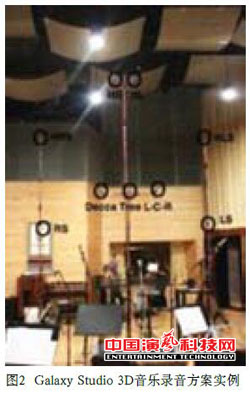 One of the advantages of this solution is that the backward compatibility of the plane surround system is excellent. In the absence of decoding, the system recorded the signal to reproduce the lower standard 5.1 surround sound recording system signal; and the upper microphone is mainly responsible for picking from the top of the hall, obliquely above the reflection of the sound, but also pick up some of the energy relative The lower layer is weaker and the sound is longer. 2.2.2 2L record company recording program Norway 2L record company (LindbergLyd) is a classical music record label in the rising star, nearly two years of its record won the Grammy Award for classical music category of a number of nominations. It is currently insisting on using DSD recording technology for recording, is currently a small number of Auro-3D format Blu-ray disc record company. In addition, 2L has a distinctive audio aesthetic concept, that multi-channel technology can break the original stage performance audience and performers between the traditional location relationship, so the production of a large number of records is the pursuit of a list of the audience The middle of the band, the audience is surrounded by all the music of the novel sound experience. The author summarizes the basic principles of 2L recording as follows: Choose the best recording site, use the most simple microphone settings, by changing the band to get the ideal balance and wonderful sound experience. 2 Ls pick-up technology draws some inspiration from DeccaTree and Mercury Tree, and its 3D pickup technology is evolving from other planar surround sound pickup technologies. Its flat surround sound pickup technology generally uses 5 or 7 microphones consisting of a pickup array. To the album "Remote Galaxy" (Figure 3) recording, for example, the plane surround sound recording, using seven microphones composed of surround sound array placed in the ring layout of the band center, as shown in Figure 4, the use of microphones are generally For the DPA all pointing to the microphone, the adjacent microphone spacing of not more than 1 m. The array of five microphones is understood to mimic the L, C, R, Ls, and Rs 5 speakers of the 5.1 playback system; and the array of 7 microphones is developed from five microphone arrays with two additional microphones located L and Ls, R and Rs, to ensure that the L, R and Ls, Rs between the sound transition is balanced, natural, mostly used for large band pickup. On this basis, 2L company to increase the top of the four full-pointing microphone to achieve Auro 3D format recording, these four microphones are located in the L, R, Ls and Rs channel microphone is just above the downward angle slightly less than Lower microphone, the height of the upper layer is equal to the lower L, R microphone spacing, as shown in Figure 5, the recording microphone array and the location of the band shown in Figure 6. The upper and lower layers of the microphone basically consist of a cube, and the size of the cube varies according to the size of the band between 120 cm and 40 cm [6]. Microphone, the 2L recording more choice all point to the microphone, but sometimeAccording to the characteristics of the music and the device in the small diaphragm microphone DPA4003 and large diaphragm microphonesDPA4041(The adjustment of the direction of the microphone spindle is more stringent)。
One of the advantages of this solution is that the backward compatibility of the plane surround system is excellent. In the absence of decoding, the system recorded the signal to reproduce the lower standard 5.1 surround sound recording system signal; and the upper microphone is mainly responsible for picking from the top of the hall, obliquely above the reflection of the sound, but also pick up some of the energy relative The lower layer is weaker and the sound is longer. 2.2.2 2L record company recording program Norway 2L record company (LindbergLyd) is a classical music record label in the rising star, nearly two years of its record won the Grammy Award for classical music category of a number of nominations. It is currently insisting on using DSD recording technology for recording, is currently a small number of Auro-3D format Blu-ray disc record company. In addition, 2L has a distinctive audio aesthetic concept, that multi-channel technology can break the original stage performance audience and performers between the traditional location relationship, so the production of a large number of records is the pursuit of a list of the audience The middle of the band, the audience is surrounded by all the music of the novel sound experience. The author summarizes the basic principles of 2L recording as follows: Choose the best recording site, use the most simple microphone settings, by changing the band to get the ideal balance and wonderful sound experience. 2 Ls pick-up technology draws some inspiration from DeccaTree and Mercury Tree, and its 3D pickup technology is evolving from other planar surround sound pickup technologies. Its flat surround sound pickup technology generally uses 5 or 7 microphones consisting of a pickup array. To the album "Remote Galaxy" (Figure 3) recording, for example, the plane surround sound recording, using seven microphones composed of surround sound array placed in the ring layout of the band center, as shown in Figure 4, the use of microphones are generally For the DPA all pointing to the microphone, the adjacent microphone spacing of not more than 1 m. The array of five microphones is understood to mimic the L, C, R, Ls, and Rs 5 speakers of the 5.1 playback system; and the array of 7 microphones is developed from five microphone arrays with two additional microphones located L and Ls, R and Rs, to ensure that the L, R and Ls, Rs between the sound transition is balanced, natural, mostly used for large band pickup. On this basis, 2L company to increase the top of the four full-pointing microphone to achieve Auro 3D format recording, these four microphones are located in the L, R, Ls and Rs channel microphone is just above the downward angle slightly less than Lower microphone, the height of the upper layer is equal to the lower L, R microphone spacing, as shown in Figure 5, the recording microphone array and the location of the band shown in Figure 6. The upper and lower layers of the microphone basically consist of a cube, and the size of the cube varies according to the size of the band between 120 cm and 40 cm [6]. Microphone, the 2L recording more choice all point to the microphone, but sometimeAccording to the characteristics of the music and the device in the small diaphragm microphone DPA4003 and large diaphragm microphonesDPA4041(The adjustment of the direction of the microphone spindle is more stringent)。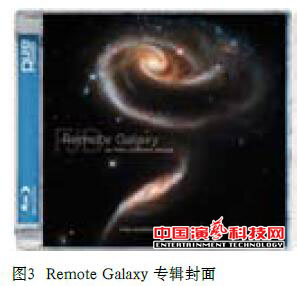
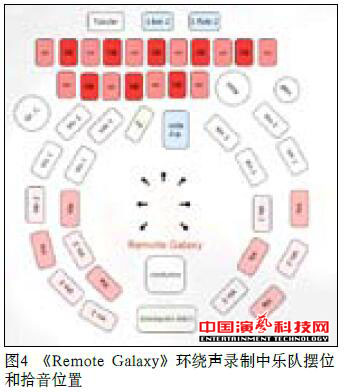
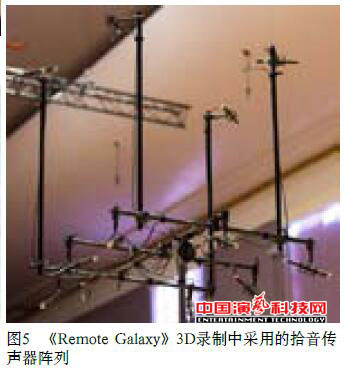
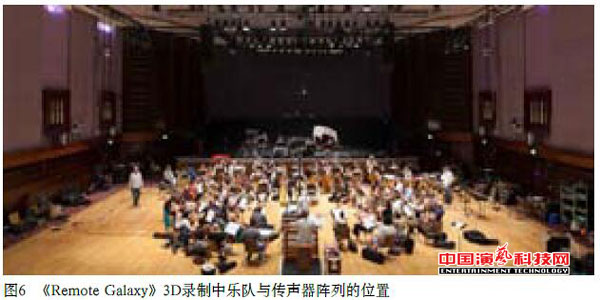 And Galaxy Studio recording program, 2Ls 3D music program pickup technology from its flat surround sound array technology, which also has the perfect backward compatibility. According to the 2L companys audio aesthetic principle, the systems microphone is very economical to use, in addition to the main microphone array almost no use of any auxiliary microphone (only occasionally to the solo instrument set up auxiliary microphone), so this recording on the hall acoustic environment, the band The location of the layout and the band itself has a very stringent sound balance requirements. 2.2.3 Zielinsky Cube 3D pickup program Zielinsky Cube is a famous German sound engineer and producer Gregor Zielinsky named 3D music recording system. In 1989, Gregor Zielinsky won the Grammy Best Classical Music Record by virtue of recording the musical "honest man" directed by Bernstein. He started in 2010 from Galaxy Studios Auro 3D research and development work, a lot of music 3D recording and production experiments, music types cover classical music, jazz, rock and other music styles. After years of 3D music recording practice, Zielinsky summed up a unique set of 3D main microphone pickup layout, called Zielinsky Cube. The system consists of eight microphones, the microphone position is just in a virtual cube (rectangular) of the eight vertex, as shown in Figure 7, Figure 8. As shown in Fig. 7, the distance between the lower L and R microphones is approximately twice the distance between the upper layer HL and the lower layer L, and the height of the remaining upper microphone can be pushed in such a way that the microphone layout is the same as that of the Auro 3D system Complete match. The lower L, R and LS, RS microphone group can be understood as the conventional large AB plus left rear right rear two surround sound microphone, L and R microphone spacing is generally between 1.5 m ~ 2 m, sometimes even larger, microphone Models are chooseed by Sennheisers MKH800twin (see Figure 9). In the case of 3D recording, when the conditions permit, the upper and lower 8 microphones use the model microphone, and sometimes the upper layer also has the choice of other heart-shaped or wide-minded to the microphone. HL, HR The microphone spindle is pointing in front, andHLS
And Galaxy Studio recording program, 2Ls 3D music program pickup technology from its flat surround sound array technology, which also has the perfect backward compatibility. According to the 2L companys audio aesthetic principle, the systems microphone is very economical to use, in addition to the main microphone array almost no use of any auxiliary microphone (only occasionally to the solo instrument set up auxiliary microphone), so this recording on the hall acoustic environment, the band The location of the layout and the band itself has a very stringent sound balance requirements. 2.2.3 Zielinsky Cube 3D pickup program Zielinsky Cube is a famous German sound engineer and producer Gregor Zielinsky named 3D music recording system. In 1989, Gregor Zielinsky won the Grammy Best Classical Music Record by virtue of recording the musical "honest man" directed by Bernstein. He started in 2010 from Galaxy Studios Auro 3D research and development work, a lot of music 3D recording and production experiments, music types cover classical music, jazz, rock and other music styles. After years of 3D music recording practice, Zielinsky summed up a unique set of 3D main microphone pickup layout, called Zielinsky Cube. The system consists of eight microphones, the microphone position is just in a virtual cube (rectangular) of the eight vertex, as shown in Figure 7, Figure 8. As shown in Fig. 7, the distance between the lower L and R microphones is approximately twice the distance between the upper layer HL and the lower layer L, and the height of the remaining upper microphone can be pushed in such a way that the microphone layout is the same as that of the Auro 3D system Complete match. The lower L, R and LS, RS microphone group can be understood as the conventional large AB plus left rear right rear two surround sound microphone, L and R microphone spacing is generally between 1.5 m ~ 2 m, sometimes even larger, microphone Models are chooseed by Sennheisers MKH800twin (see Figure 9). In the case of 3D recording, when the conditions permit, the upper and lower 8 microphones use the model microphone, and sometimes the upper layer also has the choice of other heart-shaped or wide-minded to the microphone. HL, HR The microphone spindle is pointing in front, andHLS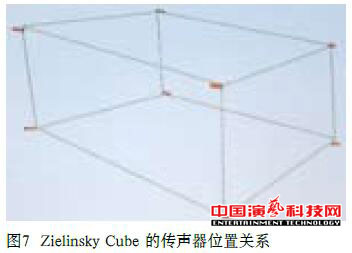
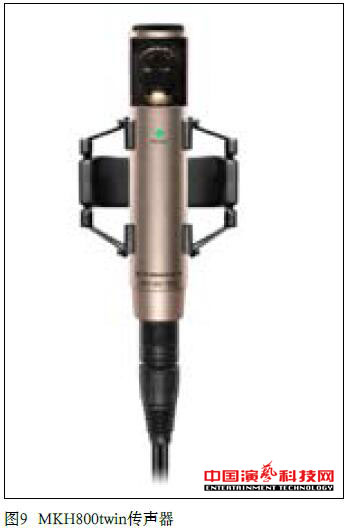 And HRS microphone are more pointed to the top of the ramp.
And HRS microphone are more pointed to the top of the ramp.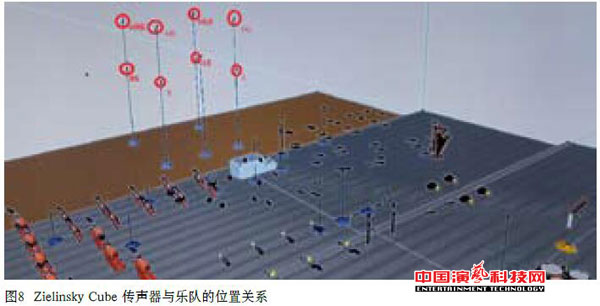 According to the above-mentioned microphone layout scheme, Zielinsky generally does not use the front intermediate channel of the Auro 3D system. He thinks that the use of the intermediate speakers does not play an important role in music recording, and it will make the transition from left to right natural. Even if a central microphone C is added to the middle of the left and right microphones according to the band preparation and hall features, only the signal is assigned to the left and right speakers at the same time as the center speaker. At the same time, Zielinsky also raised the upper and lower layers of the microphone to pick up the signal correlation problem, he thinks the upper and lower layers of the microphone to pick up the signal content must have a certain relevance, that is, the upper microphone also pick up a certain amount of sound source direct sound, only So as to ensure that the vertical reproduction of the sound field is the most natural, and can reflect the height of the sound source itself. If the upper microphone only pick up the top of the reflected sound, will lead to the entire sound field is divided into two parts, so that the sound field integrity, poor integration.
According to the above-mentioned microphone layout scheme, Zielinsky generally does not use the front intermediate channel of the Auro 3D system. He thinks that the use of the intermediate speakers does not play an important role in music recording, and it will make the transition from left to right natural. Even if a central microphone C is added to the middle of the left and right microphones according to the band preparation and hall features, only the signal is assigned to the left and right speakers at the same time as the center speaker. At the same time, Zielinsky also raised the upper and lower layers of the microphone to pick up the signal correlation problem, he thinks the upper and lower layers of the microphone to pick up the signal content must have a certain relevance, that is, the upper microphone also pick up a certain amount of sound source direct sound, only So as to ensure that the vertical reproduction of the sound field is the most natural, and can reflect the height of the sound source itself. If the upper microphone only pick up the top of the reflected sound, will lead to the entire sound field is divided into two parts, so that the sound field integrity, poor integration.
